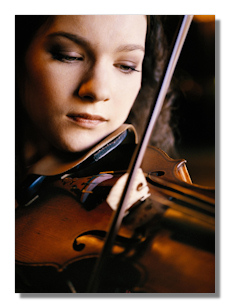
The Internet's Premier Classical Music Source
Related Links
- Latest Reviews
- More Reviews
-
By Composer
-
Collections
DVD & Blu-ray
Books
Concert Reviews
Articles/Interviews
Software
Audio
Search Amazon
Recommended Links
Site News
 Concert Review
Concert Review
Some Legends Never Die

- Henri Vieuxtemps: Violin Concerto #4 in D minor, Op. 31 *
- Piotr Ilyitch Tchaikovsky: Manfred Symphony, Op. 58
* Hilary Hahn, violin
Berlin Philharmonic Orchestra/Tugan Sokhiev
Berlin Philharmonie 31 May 2014
There is no doubt about it, catching the Berlin Philharmonic Orchestra in their iconic Philharmonie in their hometown, remains something of an event. Forget all the HD big screen broadcasts. Cliché but true: nothing beats the live experience. With a program described as "Two Symphonies, one with a soloist, one with a hero", the Berlin Philharmonic under guest conductor Tugan Sokhiev and joined by violinist Hilary Hahn, offered a remarkable evening of undiluted romanticism. Neither Tchaikovsky's Manfred Symphony nor Vieuxtemps' 4th Violin Concerto are works one would readily associate with the Berliners, but then again, lest we should forget, the orchestra has long since left the path of security and predictability when it comes to repertory choice. It's with an unusual setup like this that an orchestra can demonstrate its versatility and strength. And that's exactly what happened here.
To guide them through it all was Ossetian-born Tugan Sokhiev. One of these über-busy young maestros of today who by the looks of their schedules must be living several parallel lives at a time. As his famous compatriot Valery Gergiev, Sokhiev is a pupil of Ilya Musin at the St. Petersburg Conservatory. Particularly acclaimed in France, he currently combines the posts of Music Director of the Orchestre National du Capitole de Toulouse and of the Deutsche Symphonie-Orchester in Berlin. At the beginning of this year he added the daunting seat of Music Director of Moscow's Bolshoi Theater. Still, careers like this don't come for free. Sokhiev evidently has a way with orchestras and the Berlin Philharmonic, too, gave him their very best.
The music from the Belgian composer Henri Vieuxtemps may be snubbed by many today, but Hilary Hahn and Sohkiev proved the naysayers wrong with a stunning rendition of his 4th Violin Concerto (1850), a gripping piece of music from start to end. Hector Berlioz was full of this Concerto and called it "a symphony with first violin", hinting at the elaborate orchestral part and the four-movement structure. Sokhiev and the Berlin Philharmonic reminded us he was absolutely right. The work was last performed by this orchestra as long ago as 1927, which might explain to some extent the sense of discovery: dramatic but refined, colorful and evocative, quite the perfect canvas for Hilary Hahn's outstanding violin.
There is an interesting connection between Hilary Hahn and Vieuxtemps. Her teacher at the Curtis Institute of Music, Jascha Brodsky, studied with the great Belgian violinist Eugène Ysaÿe, who was himself a pupil of Vieuxtemps. Her magical, feather-light entrance in the first and second movement following the orchestral introduction would have been worth the price of admission, but in fact they reflected Hahn's noble and intensely lyrical approach, in perfect understanding of the piece's operatic background. While Vieuxtemps doesn't spare his soloist, it was the emotional resonance of her playing rather than the effortlessly dispatched virtuosity that we took home. It was a magnificent performance. (Her recording of the concerto is in the making and it should be a must have.)
Maestro Sokhiev has a point when he considers Tchaikovsky's vast Manfred Symphony, composed between the better-known Fourth and Fifth, unjustly neglected in the concert-hall. But then why perform it in an old-style edited form? Russian conductors like Evgeny Svetlanov and Yuri Temirkanov made their own version of the last movement, reducing it almost by half in length and adding the final part of the first movement to end the symphony on a turbulent note instead of Tchaikovsky's quiet apotheosis of remittal. Why Sokhiev wants to continue this ancient Soviet practice is anybody's guess. Many in the audience may have been unfamiliar with the work and what was being played didn't correspond with the analysis in the booklet. As it was, though, Sokhiev clearly has something to say in Manfred. He evidently knows how to handle the emotional range of the Symphony, as much as its brilliant orchestration and evocative sense, and got on all accounts an exemplary response from the Berlin Philharmonic.
The outer movements gained devastating power due to Sokhiev's unerring dramatic pacing and dynamic control. The sense of despair of Byron's hero was most poignantly expressed by the magnificent divided strings and dark-toned winds (what superb bassoons!) and brass. The flexibility of the Berlin Philharmonic seemed unlimited, and even when you thought they reached the limit, they could still take it up a notch or two without blinking. The exasperated climaxes where Tchaikovsky pulls out all the stops left one gasping for air. Yet even during the wildest moments nothing sounded forced, transparency and control prevailed. Sokhiev opted for a restrained tempo in the second movement, a tad too comfy for a Vivace con spirito, but it was so delicately done, it felt as a moment of repose, a burst of sunshine after the drama of the first movement. The rhythmic precision and careful balance vividly exposed the orchestral colors. Poetic refinement characterized most of the pastoral Andante con moto. Tenderly sculpted with elegant rubato, the quality of articulation of the strings and the sheer beauty of the woodwinds were simply breathtaking. Here was the mythical Berlin sound in all its glory. Indeed, some legends never die.
Copyright © 2014, Marc Haegeman












